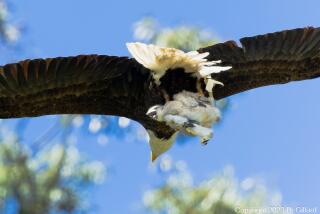CLIPBOARD : BREEDING BIRD: TREE SWALLOW <i> (Tachycineta bicolor)</i>
- Share via
Description: Tree swallows have slim, swiftlike bodies with long, pointed black wings and dark tail feathers. Coloring ranges from a glossy gunmetal blue and dark green above to white below from neck to rump. The white cheek patch does not extend above the eyes. They use their short beaks and wide gaping mouths to snatch insects while in flight. Their feet are tiny. Juveniles are grayish-brown above with a gray smudge on a white breast and belly. Adult length: 5 3/4 inches.
Habitat: Marshes, meadows or open country; usually near water.
Diet: Predominantly insects; berries when insects are not available. Occasionally gleans ground.
Displays: Courting pair performs intricate aerial courtship. Flocks perform flight displays before roosting.
Nest: Feather-lined grass nest built in tree hole, fence post or nest box.
Eggs: White, unmarked. Length: 0.8 inches.
Call: Loud chi-veet or cheet ; song is a repetitive gurgling weet, twit, weet, twit .
Notes: Flocks often seen perching in long rows on telephone wires or tree branches.
Breeding bird atlas: To report bird breeding activity in your neighborhood, or to get information on the breeding bird atlas, call Sea and Sage Audubon Society members Sylvia Gallagher, (714) 962-8990, or Nancy Kenyon, (714) 786-3160.
Note: Map is divided into 5-kilometer squares so that Audubon Society volunteers can more easily survey areas on a regular basis.
Sources: Sea and Sage Audubon Society; “The Birder’s Handbook,” Ehrlich, Dobkin and Wheye, Fireside Books (1988); “Field Guide to the Birds of North America,” National Geographic Society (1987); “Birds of Southern California: Status and Distribution,” Garrett and Dunn, Los Angeles Audubon Society (1981).
Indicates 5-kilometer-square areas where breeding activity has been confirmed.
More to Read
Sign up for Essential California
The most important California stories and recommendations in your inbox every morning.
You may occasionally receive promotional content from the Los Angeles Times.













